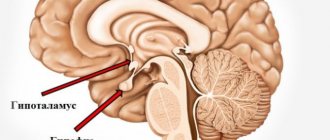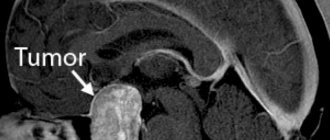Medical certificate
The main components of the brain are 4 ventricles. They are represented by small cavities. They constantly produce and circulate cerebrospinal fluid. Its main purpose is to transport nutrients to cells and remove waste products. In addition, cerebrospinal fluid plays a kind of shock-absorbing role during head impacts.
Normally, each ventricle contains about 150 ml of cerebrospinal fluid. It is completely updated three times a day. An increase in its volume provokes an increase in the size of the ventricles and a change in their shape. When the lateral C-shaped curvature disappears, the cavity becomes rounded. In this case, they speak of the initial stage of lateroventriculoasymmetry of the brain.
What it is? Such a terrible diagnosis refers to a disorder characterized by an asymmetric change in the size of the ventricles. To a small extent, such changes are not considered a pathology. However, their noticeable progression can lead to severe brain disorders. Enlarged ventricles begin to put pressure on surrounding elements and structures, causing disruption of the functioning of neurons. In some cases, death of nerve cells is observed.
Reasons for the development of the anomaly
The pathology can either be congenital or be the result of other health problems. In infants, lateroventriculoasymmetry is more common than in adults. Approximately every 500th newborn is diagnosed with an increase in the size of the ventricles, and in 80% of cases it is caused by congenital abnormalities in brain development. The remaining 20% are due to birth injuries. A child may develop intrauterine anomalies due to problems with the woman’s health during pregnancy. We are talking about such diseases as toxoplasmosis, rubella and mumps.
The causes of lateroventriculoasymmetry of the brain in adults are somewhat different. An increase in cerebrospinal fluid and, as a consequence, the size of the ventricles can be provoked by:
- skull injuries;
- previous neuroinfections (for example, meningitis);
- tumors, cysts, hemangiomas;
- thrombosis of cerebral vessels.
Accurate determination of the cause of the outflow disturbance and excessive production of cerebrospinal fluid allows you to prescribe effective treatment.
Causes
The lateral ventricles increase in size due to the following reasons:
- Tumors. They can mechanically block the outflow of cerebrospinal fluid. It accumulates in the cavities of the ventricles and stagnates, and the cavities themselves increase in size.
- Hydrocephalus. Thus, this disease is characterized by a violation of the synthesis and absorption of cerebrospinal fluid. As a result of hydrocephalus, two pathological conditions arise - occlusive hydrocephalus and aresorptive hydrocephalus. Both pathologies are characterized by impaired utilization of cerebrospinal fluid, which accumulates in the ventricles and they expand, causing lateroventriculoasymmetry.
- Congenital structural features of the central nervous system, due to which the child was already born with dilated and asymmetrical lateral ventricles.
- Traumatic brain injuries.
- Subarachnoid hemorrhage, cerebral hematoma.
Clinical picture
Moderate lateroventriculoasymmetry of the brain does not affect the human condition. We can talk about the development of a pathological process in the presence of pronounced changes in the lateral ventricles. In this case, the patient feels the symptoms of the primary disease, which provoked lateroventriculoasymmetry. This may involve problems with sensation, memory, coordination or thinking. Typically the patient complains of:
- pain in the head, a feeling of squeezing and bursting;
- nausea and vomiting, especially in the morning;
- dizziness;
- state of anxiety.
The patient is constantly accompanied by apathy and drowsiness. Such symptoms of lateroventriculoasymmetry of the brain indicate that the pathology is progressing. As a result of impaired outflow of cerebrospinal fluid, pressure on the brain increases, which leads to:
- oculomotor disorders;
- development of dementia;
- blurred vision;
- urinary incontinence;
- impaired motor function (gait becomes unsteady).
If treatment for the anomaly is not started in a timely manner, it can become chronic.
Symptoms of enlarged ventricles
The mechanism of development of pathology has common features, regardless of the reasons. Fluid accumulates in the ventricles, which expand and contract brain tissue. The pressure in the cavities themselves also increases.
Patients may complain of sudden headaches, nausea and vomiting, a feeling of distraction in the eyeballs, hearing and vision problems. Performance gradually decreases, memory impairment, apathy, and drowsiness appear.
All these are symptoms of pathology of the spinal system. If the abnormality is not detected and treated early, it becomes a chronic condition.
Course of the disease in children
The manifestation of the pathological process in young patients depends on age. Children are usually capricious and do not eat well. Their gaze is directed downward, but their eyes are excessively open. In children, the bones of the skull are flexible and plastic. Therefore, disorders can manifest themselves in an increase in head size. Pulsation of the fontanel and swelling of the veins are often observed.
School-age children also suffer from lateroventriculoasymmetry of the brain. Only a few know what kind of disease this is. Its development may be preceded by congenital disorders of brain formation or failures at the genetic level. At this age the disorder manifests itself:
- divergence of seams between the bones of the skull;
- slow development;
- overweight;
- sudden mood swings;
- impaired ability to move the eyeballs;
- problems with mental activity;
- decreased attachment to loved ones.
In adolescents, this disease is a consequence of cranial injuries or previous infections. It is accompanied by severe headaches, vomiting and nausea, and convulsions. Psychosis cannot be ruled out.
Symptoms
The severity of symptoms depends on the expansion. Thus, a slight change in the volume of the cavity may not appear. Lateroventriculoasymmetry causes a nonspecific clinical picture (general cerebral symptoms):
- Periodic aching headache of a bursting nature. May worsen with sudden head movements.
- Dizziness.
- Nausea and vomiting not associated with food intake.
- Sleep disturbance, irritability, emotional lability.
- Noise in the ears, decreased visual acuity, pain in the eyes.
- Decreased performance.
There are no specific clinical signs that would suggest lateroventriculoasymmetry. To detail and clarify the nature of the symptoms, it is necessary to conduct instrumental diagnostics.
The clinical picture in children usually appears after birth, as indicated by objective signs: pulsation and divergence of the sutures between the cranial bones, delayed psychomotor development, gait disturbance, frequent tearfulness, disordered sleep-wake ratio. The clinical picture in adolescents and the elderly is the same as in adult patients.
Diagnostic methods
Prescribing treatment and explaining what lateroventriculoasymmetry of the brain is is the task of a specialist. If symptoms of the disorder appear, you should immediately consult a therapist. After studying the clinical picture and complaints, the doctor will refer you to a neurologist. It is this specialized specialist who can confirm the preliminary diagnosis. For this purpose, he prescribes a comprehensive examination to the patient, which consists of the following activities:
- CT, MRI. These methods are considered the most informative. Using tomography, you can assess the condition of the ventricular system and determine the causes of impaired outflow of cerebrospinal fluid.
- Echoencephaloscopy.
- Electroencephalography.
- Fundus examination.
If the listed options for diagnosing lateroventriculoasymmetry of the brain give conflicting results, a lumbar puncture is prescribed. The results of cerebrospinal fluid analysis can accurately determine the causes of deformation of the lateral ventricles.
Link to mental disorders
The publication of the American Journal of Psychiatry contains an article with a meta-analysis. The article states that thanks to the massive magnetic resonance imaging of patients with schizophrenia and healthy people, differences were found in the structure of the ventricular system. Thus, in the conclusion it is stated that in patients with schizophrenia, in addition to a decrease in the volume of the frontal and temporal cortex, a difference was found - an expansion of the volume of the lateral ventricles.
A 2008 meta-analysis described a nonspecific change in patients with bipolar affective disorder. Thus, the article indicates that in such patients, unlike healthy people, the lateral ventricles are dilated.
Drug therapy
Treatment of lateroventriculoasymmetry of the brain with drugs is prescribed only when the clinical picture is severe. The main direction of such therapy is the elimination of the underlying disease, which provoked a change in the size and shape of the ventricles. For this purpose, drugs from the following groups are recommended:
- Diuretics.
- Neuroprotectors.
- Vascular agents.
- Nootropic drugs.
- Sedative medications.
- Anti-inflammatory drugs.
All medications, as well as their dosage, are selected individually.
The need for surgery
When conservative therapy is ineffective, surgery is prescribed. A puncture is performed at the site of the greatest accumulation of cerebrospinal fluid. If the cause of compression of the cerebrospinal fluid outflow tract is a tumor, it must be removed.
In modern medical practice, ventricular bypass surgery has become widespread in the treatment of lateroventriculoasymmetry. During the procedure, the doctor installs a shunt, with the help of which cerebrospinal fluid begins to flow into the bladder. After the operation, the patient can return to the usual rhythm of life. Intracranial pressure gradually decreases, and other symptoms of illness disappear. Unfortunately, in half of the cases, shunting loses its effectiveness over time. The development of complications, including inflammation of soft tissues and the addition of a secondary infection, cannot be ruled out. In this case, a repeat operation with replacement of the shunt is required.
Consequences of the disease
A common question that almost all patients diagnosed with “lateroventriculoasymmetry of the brain” ask specialists: is it dangerous? It is not possible to answer this unequivocally.
If there is an unexpressed form of the disease, when changes in the lateral ventricles do not cause discomfort to the patient, specific therapy is not required. Simply observing the anomaly is enough. In case of progressive disease, treatment is necessary. It can be either medicinal or surgical. If you ignore the symptoms of the disorder and do not seek help from a doctor, the likelihood of complications increases. In addition to impaired consciousness and motor function, such a patient is at risk of coma.









